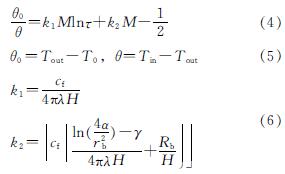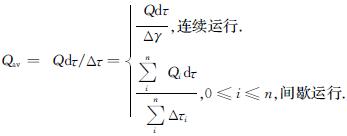基金项目:国家自然科学基金资助项目(51578221)
第一作者:山占鹏(1996-),男,硕士生,主要从事可再生能源技术研究. E-mail:shan_zp@hnu.edu.cn 通信作者:杨昌智(1963-),男,教授,主要从事建筑节能方向研究. E-mail:yang0369@126.com
(College of Civil Engineering, Hunan University, Changsha 410082, China)
ground source heat pump; heat transfer model; heat transfer performance; test method; design method
DOI: 10.15986/j.1006-7930.2021.06.007
土壤源热泵作为一种浅层地热能利用技术,因其效率高、不受季节气候影响,易与其他能源耦合等特点,受到越来越多的关注[1-2]. 目前,土壤源热泵系统已广泛应用于住宅和公共建筑的采暖、制冷和生活热水,安装量在不断增加[3]. 据报道,到2017年底,中国已安装的地源热泵装机总量达2万兆瓦,居世界第一[4]. 随着土壤源热泵的进一步推广应用,准确、可靠的热响应测试和工程设计方法显得越来越重要.
对于土壤源热泵系统工程设计而言,地埋管换热器(Ground heat exchanger, GHE)的换热能力是核心内容,该值取决于系统所处深度范围内土壤的综合热物性[5],因此设计前须进行土壤热物性测试. 传统土壤热物性参数主要是通过查表[6]或者实验室取样测值[7]的方法获得.目前,现场热响应测试被认为是确定热物性参数和GHE设计尺寸的一种可靠方法[8-9],大型土壤源热泵系统设计前进行热响应测试已成为许多国家的普遍做法. 我国现行的《地源热泵系统工程技术规范(2009版)》[10]沿用了这种现场测试技术,即采用恒热流热响应法(Thermal response test, TRT)测试土壤的导热系数和钻孔热阻,进而由此计算给定传热温差下单位井深换热量的参考值,设计人员据此进行埋管量的设计.
由于GHE设计参数对土壤源热泵系统初投资具有重要影响,许多学者研究了提高热响应测试结果准确性的方法. 对于换热模型解析和数值方法,许多学者进行了相关研究[11-18]. 此外,人们也研发了一些新的热响应测试方法[19-21]. 尽管目前进行了大量的研究工作,但目前通常的土壤源热泵设计方法是基于TRT,通过数值或解析模型间接计算地埋管换热能力. 受测试条件和理论模型限制,存在以下不足:(1)TRT无法直接计算GHE的瞬态换热能力,基于TRT的间接计算会因GHE精确的几何细节(如回填材料的热物性等)较难准确获得[22]而导致结果不准确;(2)TRT假定注入土壤的热流为单孔的预期负荷,但由于土壤自然对流的存在,使得合适的热流注入速率难以准确确定[23].工程中通常选择30~80 W/m间任意值[24]的做法增加了现场测试结果的不确定性;(3)GHE瞬态换热量随系统运行的变化在设计前无法预知,导致设计阶段有时会使用过多的辅助热源或应用较大的安全系数对系统进行过度设计,进一步造成初投资浪费.
恒温热响应测试是近年来出现的一种测试方法,该方法可直接获得GHE单位井深换热量. 目前陆续有学者对恒温热响应测试进行了研究. Wang等[25]通过改进TRT装置进行了恒温热响应测试,结果表明与传统的恒热流法相比,恒温热响应测试具有精度更高、实现稳态时间更短、温度测试范围更广等重要优点. Yu等[26]通过恒温热响应测试估算了土壤导热系数,结果表明恒温热响应测试可以明显缩短GHE与周围土壤达到稳态传热的时间. Aydin等[27]提出了一种通过恒温热响应测试计算土壤导热系数的新方法,该方法无需估计土壤热容. 此外,Choi等[28]提出了一种新的恒温热响应测试装置,并估算了GHE的设计参数. Jia等[29]使用可以同时进行注热和取热的恒温热响应测试装置,估算了土壤导热系数.
为进一步解决工程设计中存在的上述问题,结合恒温热响应测试测试时间短、运行稳定性好的优点,本文提出一种土壤源热泵系统测试与设计方法. 该方法首先基于线热源模型和理论分析,提出了反映土壤侧换热规律的恒温热响应测试动态传热模型,并通过现场测试验证了模型的正确性. 其次,通过恒温热响应测试,研究了不同模式下GHE的传热特性. 最后,针对不同运行模式下土壤源热泵系统的工程设计,特别是间歇运行,提出单位井深换热量积分平均值的新指标,该指标可避免因采用连续运行模式下GHE换热量稳态值而有可能导致的系统设计容量过大问题. 本文所提出的新的测试方法规避了TRT测试时,因求解土壤导热系数和钻孔热阻等热物性参数而产生的不确定因素,通过恒温热响应测试可较准确、快速地计算出GHE的瞬态换热量的值. 本文所提出的土壤源热泵测试与设计方法,可为土壤源热泵系统设计和运行提供一定理论指导.
根据无限线热源模型,地埋管流体的过余温度响应可写成时间与距离的函数,当ατ/r2≥5时,如式(1)所示[30].
T(r,t)-T0=Q/(4πλH)Ei((r2)/(4ατ))≈Q/(4πλH)[ln((4ατ)/(r2))-γ](1)
式中:T(r,t)为τ时刻半径r处的土壤温度,℃; T0为土壤远边界初始温度,℃; Q为埋管热流,W; H为钻孔深度,m; λ为土壤导热率,W/(m·℃),α为土壤热扩散系数,m2/s; γ为欧拉常数,γ=0.577 2.
令钻孔灌浆回填材料的热阻为Rb,则由传热学理论,地埋管内流体平均温度与钻孔壁温之间的关系可表示为式(2).
Tf-Tb=Q/HRb(2)
Q=cfM(Tout-Tin)
Tf=((Tin+Tout))/2(3)
式中,cf为循环流体质量比热,J/(kg·℃); Tin为GHE进口温度测量值,℃; Tout为GHE出口温度测量值,℃; Tf为GHE内流体平均温度,℃; Tb为钻孔壁温,℃; M为循环流体质量流量,kg/s.
结合式(3),令r=rb,由式(1)和式(2)可得出埋管内流体出口温度随时间的变化关系式:

分析式(4)可以看出,需要确定两个未知参数,反映土壤热物性的参数k1和k2.对于一个确定的钻孔来说,孔深、管径、回填材料等均为常数,其进出口温度无量纲数仅与流量和运行时间有关. 由于土壤注入热流Q已知,故给定初始设计的进出口温差θ时,流量M便可确定.此时,固定GHE的入口温度(例如35 ℃),GHE出口温度Tout是lnτ的一次函数.通过恒温热响应测试在稳定运行期间所获得的流量M及不同时刻进出口温度(Tin,Tout),便可根据式(4)确定热物性参数k1、k2的值.
进一步,可得单位井深换热量为
ql=(cfM(Tin-Tout))/(H)(7)
上述基于线热源恒温热响应动态传热模型的实际意义在于:可以通过热响应测试获得反映土壤热物性的参数k1和k2; 利用该传热模型,结合热泵模型可构成整个土壤源热泵系统动态仿真模型,进行土壤源热泵系统设计和优化. 因为热泵性能与GHE的传热特性是通过流体温度来耦合的,所以在给定房间负荷及GHE设计进口温度的条件下,可通过迭代确定运行一定时间后流体出口温度值,从而可以简单、快速计算出单位井深瞬时换热量,计算过程详见图1.
本实验于2021年4月20日至5月20日在湖南省长沙市进行,实验装置示意图如图2所示,主要包括:循环管路系统、PID控制系统及测量系统. 其中地下埋管部分由一个埋设有外径32 mm、内径26 mm的高密度聚乙烯垂直单U型管的钻孔组成,钻孔直径150 mm,井深为18.8 m,采用膨润土-砂浆混合物回填. 图3是现场恒温热响应测试平台.实验使用的设备型号参数如表1所示.
保温水箱内设置功率为4 kW电阻加热器,通过与PID控制器结合控制进口温度恒定. 其原理是PID控制器根据地埋管进口处PT100传感器测量的入口温度和设定温度之间的差值,将所需要的输出发送到电磁继电器(SSR),SSR通过控制电阻加热器频率调节加热器的实时输出,来保证GHE进口温度恒定.流量通过控制阀调节. 在实验期间,暴露在室外环境中的管道和水箱进行保温处理,最大限度减少外部环境传热干扰. 该测试系统相比传统TRT装置,在原先设备基础上增加了PID控制系统,因此成本也会随之增加.
该测试所用的仪器及其精度如表2,GHE进出口温度采用PT100铂电阻传感器测量,分别设置在GHE出水和回水管道上,每5秒自动测量一次. 流量采用电磁流量计测量,用钳形电流表测量电加热器的功率.
Tab. 2 Measuring instruments and their accuracies
从2021年4月底开始,设定进口温度37 ℃,进行多次连续运行和间歇运行实验. 实验中流量0.72 m3/h,通过测试比较GHE在不同运行模式下的传热特性.
本次测试开启电加热之前,先开启循环水泵让水在钻孔中循环. GHE进出口温度每隔5秒测量一次,直到进出口温度达到稳定状态(5 h内温度相差不超过0.1 ℃),以此作为地下土壤的初始温度. 在现场测试中发现,经过40 h后进出口温度趋于一致,测量值为19.8 ℃,因此将19.8 ℃作为未受扰动的土壤初始温度.
本文建立了恒温热响应测试传热模型,将进口温度和流量作为模型输入参数,通过对比GHE出口温度计算值与实测值的一致性进行模型验证.已知钻孔的相关参数:钻孔深度H为18.8 m,钻孔半径rb为0.055 m,土壤导热率λ为2.52 W/(m·℃),土壤热扩散系数α为9.2×10-7 m2/s,钻孔热阻Rb为0.12 m·℃/W. 由现场的测试,得到土壤的初始温度19.8 ℃.进口温度设定为37 ℃、流量为0.32 m3/h. 图4给出了夏季工况下连续运行48 h GHE出口温度计算值和实测值的变化曲线,图5为其误差分析.
由图4可知,GHE出口温度计算值与实测值吻合度较好. 开始的5 h内出口温度随进口温度的波动具有明显的振荡变化,此后逐渐趋于稳定. 分析图5可得,实测进口温度到达设定值37 ℃后的最大超调量为0.5 ℃. 前5 h内,GHE出口温度的计算值与实测值绝对误差较大,最大绝对误差达4 ℃,此后随着运行时间的增加绝对误差逐渐减小. 主要原因是钻孔内传热由刚开始的非稳态逐渐向稳态过渡. 进一步分析可以看出,当系统连续运行经过15 h后,计算值与实测出口温度之间的绝对误差均小于±0.1 ℃,相对误差均在2%以内,表明GHE换热模型与实验结果具有很好的一致性.
图4 GHE出口温度计算值与实测值的对比
Fig.4 Comparison of outlet temperature of GHE for calculated value and test value
本节对GHE在不同运行模式下传热特性的实验结果进行了介绍和分析.
图6所示为连续运行48 h下GHE的出口温度和单位井深换热量随时间的变化. 分析图6可知,开始的5 h内GHE出口温度迅速上升,此后随着运行时间的增加趋于平缓. 如第5小时内温升为0.2 ℃,而在第10小时内温升不足0.1 ℃,超过35 h后出口温度为35.1 ℃,5 h内温升不超过0.1 ℃,达到稳定状态,此时的温差为1.9 ℃. 这主要是因为土壤源热泵在启动开始一段时间传热是不稳定的,但当运行一段时间后会逐渐达到稳定状态,此时GHE的各特性参数变化比较缓慢. 此外可以看出,单位井深换热量随运行时间的增加表现为先急剧下降后趋于平缓,运行35 h稳定后单位井深换热量为42.2 W/m. 分析可知,主要原因是连续运行导致地温升高,埋管内流体与土壤间温度梯度变小,换热能力下降.
根据《地源热泵系统工程技术规范(2009版)》[10]的要求,在工程应用中,当水温12 h内波动不超过1 ℃时达到稳态. 恒温法热响应测试达到稳态的时间约为35~40 h,TRT则约为55~60 h[26]. 本文实验表明达到稳态时间约为35 h,与TRT相比,恒温热响应测试可以缩短测试周期. 因此,随着土壤源热泵的进一步推广和应用,对缩短测试持续时间的需求也日益增加,恒温热响应测试是一种较好的解决方法.
图7所示为间歇运行(间歇比1:1)48 h下GHE的出口温度和单位井深换热量随时间的变化. 分析图7可以看到,间歇运行下GHE出口温度和温差随运行时间在小范围内波动,但无明显的上升趋势,稳定后的进出口温差为2.5 ℃. 单位井深换热量表现为周期性的波动变化,刚开始运行的前5 h急剧下降,稳定后趋于平缓. 分析可知,前5 h内,地埋管中的温度与土壤间温度梯度大,换热量大; 随着系统运行时间的增加,运行稳定后单位井深换热量为55.6 W/m.
图8给出了两种不同运行模式下GHE传热性能的对比.
分析图8(a)可以看出,开始启动时两种运行模式的出口温度随时间变化的规律一致. 运行35 h后,连续运行出口温度为35.1 ℃,间歇运行出口温度为34.5 ℃,两者相差0.6 ℃. 由图8(b)可知,刚开始启动的12个小时内,两种运行模式的单位井深换热量几乎相同,但随着运行时间的增加,连续运行模式下的单位井深换热量逐渐下降,35 h后间歇运行的单位井深换热量比连续运行高达13.4 W/m.
由此不难发现,相同的进口温度和流量,GHE间歇运行下出口温度更低,单位井深换热量更大,换热效率也更高,且随运行时间的增加,对传热性能的影响更加明显. 主要原因是间歇运行相较连续运行,积聚在GHE周围的热量有更多的时间可以扩散,土壤温升更小,从而使换热得到加强.
值得注意的是,GHE的换热能力现有的研究大多数都是根据式(7)来计算,在土壤源热泵系统工程设计中常采用以该方法为基础的GHE换热性能的稳态值(如本文连续运行35 h后的单位井深换热量)作为依据. 显然,该方法更多地侧重于土壤源热泵系统在连续运行模式下换热性能瞬态值的计算,并未考虑在热响应测试在达到稳定状态之前的换热时间. 其次,实际的系统运行工况更多的是间歇运行,因而采用连续运行模式下GHE换热性能的稳态值,可能会导致系统设计容量偏大. 为进一步反映地GHE在连续运行和间歇运行两种不同模式下的综合换热特性,本文提出了一个考虑系统不同运行模式和运行时间的新指标Qav,其定义如下:
 (8)
(8)
式中:Qav表示埋管热流的积分平均值,W; Δτ表示运行时间,s; i表示间歇运行的第i个启动时段. 对于连续运行,Qav就是求运行时间内GHE瞬态换热量的积分平均值; 对于间歇运行,则是将各启动时段内的换热量和运行时间求和,再计算其平均值. 进一步,单位井深换热量ql的积分平均值可以表示为
qav=(Qav)/(H)(9)
式中,qav为单位井深换热量的积分平均值,W/m.
基于qav的研究结果,本文通过实验测试数据,利用该指标对GHE在连续运行和间歇运行模式下的换热性能进行计算,结果如图9所示. 可以看出,间歇运行下单位井深换热量的稳态值和积分平均值均比连续运行高,再次表明间歇运行可以提升土壤源热泵的换热性能. 其次,连续运行下单位井深换热量的稳态值为42.2 W/m,积分平均值为49.1 W/m,两者相差6.9 W/m; 间歇运行下的稳态值为55.6 W/m,积分平均值为61.4 W/m,两者相差5.8 W/m. 两种模式下,单位井深换热量的积分平均值均比稳态值高. 究其原因,主要是积分平均值考虑了测试在达到稳态之前的运行时间的加权作用. 基于实际运行大多为间歇运行的特点,该指标相比式(7)的计算方法,更能反映GHE的传热特性. 采用该值作为设计参考值,可以避免因采用稳态值而可能导致的系统容量过大,造成初投资浪费的问题,同时设计时也能保证整个季节的运行安全.
本文针对土壤源热泵系统在工程设计中存在的TRT较难提供准确热物性参数、埋管计算量不准确问题,提出了一种土壤源热泵系统测试与设计方法,主要结论如下:
(1)提出的土壤源热泵系统测试与设计方法,可通过恒温热响应测试直接确定土壤热物性的参数k1和k2,进而快速、准确计算GHE出口温度和单位井深换热量.该方法规避了TRT因求解土壤导热系数和钻孔热阻等热物性参数而产生的不确定因素,可为土壤源热泵工程设计提供理论指导;
(2)本文建立的恒温热响应测试动态传热模型对GHE出口温度的估计,同实验结果相比,运行5 h后绝对误差小于0.5 ℃,相对误差小于2%,在工程应用中具有可行性[8];
(3)实验研究结果表明,间歇运行相较连续运行,可提升GHE的换热性能. 本文提出的单位井深换热量积分平均值新指标,考虑了土壤源热泵系统不同运行模式和运行时间的影响,可有效避免因采用传热稳态值而导致的系统容量设计过大问题.